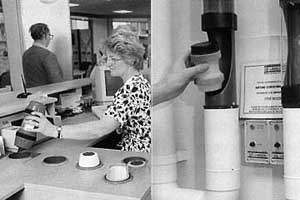
You are most likely to see capsule pipelines in shops or banks. If you look closely you might spot this: the capsule being dropped into the pipeline. What would happen if there was no capsule pipeline here? (picture source: D.D. Lamson)
Capsule pipelines could be used to transport almost anything. They are actually used to transport very little.
The most common use is to transport small items short distances within buildings, or between two buildings that are close together. Some of the capsules used are as small as your hand, most are a little larger. They are made of plastic and have screw tops to allow the items they are transporting to be put inside. The capsule is feed into a pipeline. Air is used to move the capsule along the pipeline to another location, somewhere in the same building. Capsules travel at about 5 metres per second.
Hospitals use these to move medical samples from the wards, where the patient gives the sample, to test laboratories, where the sample is tested. Banks, supermarkets and other shops use these to move cash (coins and banknotes) from check-outs to safe storerooms. Some offices and factories use them to transport paper documents.
If these systems did not exist the items would have to be transported by hand. The journey would take longer, it would be less safe, and would take more time for the staff. Like all pipelines, capsule pipelines are normally well hidden, but keep looking, and eventually you will find one.
Much larger capsule pipelines are used to move rock or stone from mines to rock crushing machines. The pipelines are more than one metre wide, with several sets of capsules being moved at once. The capsules are made of metal, with rubber tyres which allow the capsule to travel to move more easily within the pipeline. The longest capsule pipeline is in Georgia (in the former U.S.S.R.), which is 49 kilometres long. Capsules take about an hour to travel from one end to the other. There are only a few large capsule pipelines currently in use in the world.
Think about it...
What do you think are the advantages and disadvantages of using capsule pipelines to move items around buildings? What are the alternatives?
If capsule pipelines can be used to transport almost anything, why are they only used for certain journeys and goods? Do the different journeys and goods they are used for have anything in common with one another?